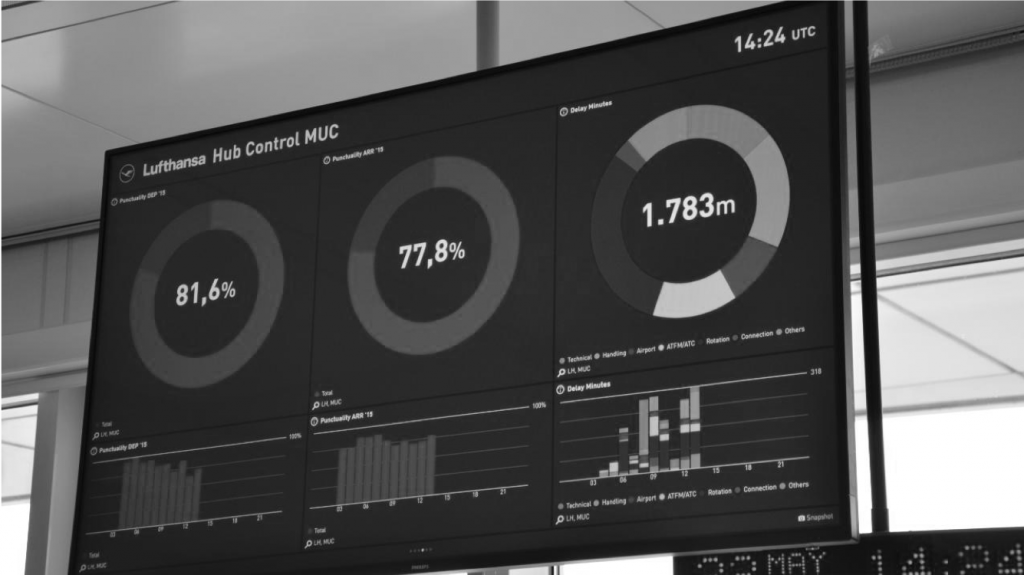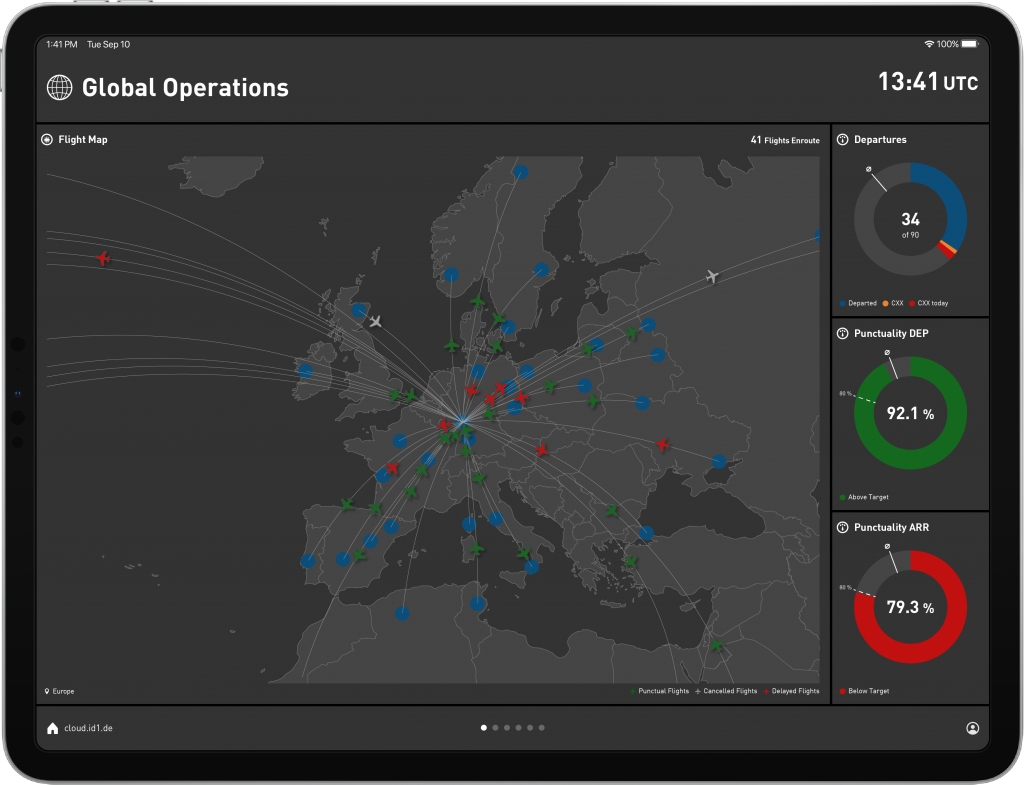I talk to lots of guys from airlines about real-time operations dashboards. Thus, I can learn about people’s perceptions and dogmas when it comes to dashboards. Talking about things like, what are the benefits of dashboards? Who should use it? What are the efforts? Etc.
And quite often, I realize a considerable discrepancy between people’s understanding and perceptions and the experience I’ve made when setting up KPIs and real-time dashboards for many clients.
That’s why I put together 12 of the most important and most often made statements — and explain why they are wrong and sometimes even dangerous.
#1 — Airline Operations Dashboards Are Only For Operations Control Center
A statement I heard so many times in my career — and probably the one most wrong. Indeed, the Operations Control Center is a department that comes to one’s mind first when thinking about real-time operations dashboards. And OCC is a department that definitely benefits from using a real-time dashboard. When I take a look at our clients, all of them have equipped their OCCs with a dashboard.
But here comes the but: OCC is only one department that benefits from real-time dashboards. And there are many more out there. Operations Manager, C-Level Executives, Ground Staff, Flight Crew, Flight Operations, Cabin Crew, Briefing Rooms, Customer Communication Center — this list is endless.
Quite often, other departments/people than the OCC can realize even more benefits from using real-time operations dashboards. Why? Because previously, they had almost NO access to this information.
Summarized: OCC definitely is a must-have user group. However, if only used in OCC, you waste a huge, huge potential.
#2 — I Don’t Want To Provide The Information To The Management
Another statement I love: “If we introduce real-time KPIs and provide access to our top management level, they will start to call constantly, chase, and bug us.”
When confronted with this statement first, I actually did not know what to answer. Simply because this was a view I’ve never thought about before. It took me some time to digest and think through. Today I have two obvious answers, why this is a wrong perception.
Firstly, I think your top management has a busy calendar. I hope and don’t think they’ll have time to monitor your KPIs continually and give you a call whenever they discover an irregularity.
Given the fact they do, or they just accidentally discover some question marks (which is much more likely) and directly give you a call. How great is that? Firstly, what’s better than management is taking your work and the related KPIs seriously.
Secondly, what’s better than having a direct line to your management in case of irregularities. You can directly explain or even get his support — wow!
#3 — Weekly/Daily Reports Are Sufficient
I’m always surprised when hearing that statement. But I can tell you it’s that unusual. The thing is that weekly/daily reports that show your most important KPIs and real-time KPI monitoring are two completely (really completely!) different use cases.
A daily/weekly report summary of what has happened. It’s something like taking inventory to finalize a period. Real-time KPIs give you the possibility to understand what is happening right now at this very moment. And based on that, it helps you to identify current problems and counteractions.
Ultimately, real-time dashboards and KPIs help to improve the final figures you see on your daily/weekly reports.
#4 — As a Small Airline The Effort For An Airline Operations Dashboard Is Way Too High
That statement is way too generic. It depends on your requirements. If you want to go for 50 different KPIs, develop the solution in-house, and don’t even have the necessary data sources — then, yes, you’re right.
On the other side, if you go for standardized products —and I’m not only talking about our product— the effort to implement and operate is reasonable even for small airlines.
Luckily we are living in the golden ’20s: Things like cloud, pay-what-you-use, standardized interfaces, etc. reduced complexity massively. And furthermore, those developments give small companies the possibility to use solutions that were reserved for the big ones in previous times.
If you want some more details about costs and efforts, you should check out these two blog posts:
How long is the typical project duration to set up an Airline Operations KPI dashboard?
What you should know about the pricing of airline operations real-time dashboards?
#5 — Real-Time KPIs And Airline Operations Dashboards Won’t Help To Improve Our Operations
Hm, tough statement.
Probably if somebody isn’t convinced that an approach or a solution helps, it doesn’t make sense to continue.
Nonetheless, I always try to convince with facts. And based on our experience with clients, we can provide clear evidence that real-time KPIs have the power to improve operational KPIs (first and foremost OTP) and ultimately generate savings.
I wrote a complete article on that aspect you may want to go through:
How small airlines generate savings of €365,000 annually with real-time operations dashboards.
#6 — Our Management Is Not Interested In Real-Time KPIs
Actually, I don’t know where this dogma comes from.
Why shouldn’t your management be involved in the most critical and most important performance factors? Of course, they are also interested in financial figures, sales numbers, etc.
If your management really isn’t interested in these numbers, your airline is facing some severe problems.
#7 — We Operate An Operations Control System — That’s Sufficient
Short answer: No.
Medium answer: Refer to point 1
Long answer: There are two reasons why this dogma is incorrect.
First of all and as explained with point number 1, real-time dashboards are not solely focused on an operations control center. Conversely, dashboards unfold their full potential when used in other areas.
Secondly, the use cases of operations control systems and real-time dashboards are entirely different. An operations control system is used to manage flights, perform changes, track rotations, etc.
Real-time dashboards are used to create an overall situational awareness. Two things that are completely different.
#8 — We Don’t Have The Manpower To Set Up And Operate An Airline Operations Dashboard
This statement is similar to aspect number 4. And in most cases, it is wrong.
Again, if you decide to develop an entire solution (with several KPIs, a fancy design, and optimized for different devices) in-house, the statement might be right.
On the other side, when choosing an off-the-shelve solution, you should choose a solution that requires very limited manpower input from your team.
As you can read in one of our latest blog posts, it is actually possible to set up a dashboard in one month. And that requires minimal input from the client-side.
#9 — We Already Show The OTP In Our Operations Center — That’s Sufficient
On-time performance indeed is one of the most critical KPIs. But concentrating on OTP only can be dangerous.

Especially since the more massive or more complex your operations, the more sophisticated KPIs you need to be aware of the whole situation. But you don’t necessarily need lots of additional complex KPIs.
What you need are those KPIs that provide a holistic view of your operations. On-time performance is one pillar. So is regularity, delay reasons, maintenance aspects, etc.
Summarized: OTP is essential, but you shouldn’t narrow your view too much towards only one KPI.
#10 — This Is Something We Can Develop In-House
It depends on what you are looking for. I’m pretty sure that your IT department can develop a simple dashboard showing the OTP in your OCC.
But if you want to go for a cutting-edge real-time solution, containing a vast amount of ready-to-use KPIs, mobile apps, additional functionalities that go beyond dashboards — I’d say, no you don’t.
Don’t get me wrong —especially if you’re working in an IT department— but this is what I’ve experienced many times.
#11 — There’s No Need For Mobile Solutions
Another comment I’ve heard often is “we just need a huge TV screen with KPIs; mobile solutions are not necessary.”
Usually, I won’t comment on this or try to convince with facts. But what I do is provide an account to the mobile solution and let the guys use it for a few weeks.
The percentage who had the same conviction after two weeks is roughly 0 — even lower 😉

#12 — An Airline Operations Dashboard That Shows High-Level KPIs Isn’t Sufficient — I Want To Dig Into The Detail, Drill-Down And Analyze Root-Causes
Actually an excellent thought. And you should definitely have a solution that enables data analytics. Tableau or PowerBI is a perfect choice to do that.
But similar to one of our blog posts that talks about why Tableau isn’t the right solution for real-time dashboards — real-time dashboards haven’t been designed and developed for the use case of analytics.
So, it’s up to you what you are looking for. A data analytics platform or a solution that enables perfect situational awareness.
What Do You Think?
Always happy to receive your feedback and thoughts. Just hit me up on Twitter or get in touch on LinkedIn.





